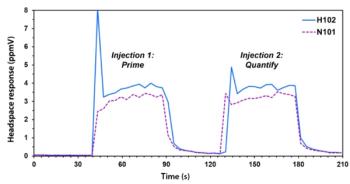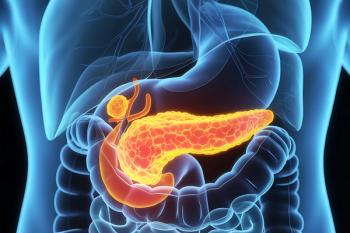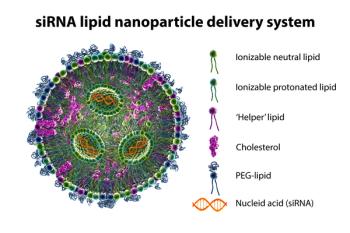
Separating and Quantifying Spinach Flavonoids with UHPLC–MS/MS
Researchers at Baylor College of Medicine’s Children's Nutrition Research Center (Houston, Texas) developed and validated a high-throughput extraction and ultrahigh-performance liquid chromatography–tandem mass spectrometry (UHPLC–MS/MS) method to separate and quantify 39 spinach flavonoid species in 11.5 min.
Researchers at Baylor College of Medicine’s Children's Nutrition Research Center (Houston, Texas) developed a high-throughput extraction (48 samples/h) and comprehensive quantification method (39 flavonoids/11.5 min) using ultrahigh-performance liquid chromatography tandem mass spectrometry (UHPLC–MS/MS) to gain additional insight into the diversity of spinach flavonoids. A summary of their experiments, validating their methods and providing benchmark concentrations for spinach flavonoids in a genetically diverse population, was published in Frontiers in Plant Science (1).
Flavonoids are secondary metabolites that play key roles in flower pigmentation (facilitating pollination), absorbing UV light in leaves, and providing protection against both biotic and abiotic environmental stressors (2,3). Spinach (Spinacia oleracea) produces a remarkable quantity of flavonoids, with reported concentrations varying between 82–224 mg/100 g fresh weight (4,5). Owing to their reported antioxidant and anti-inflammatory properties, spinach-derived flavonoids have been associated with a reduced risk of developing certain cancers, neurodegenerative, and cardiovascular diseases (2,6–11).
Quantification of spinach flavonoids is generally done by reverse phase liquid chromatography tandem mass spectrometry (RPLC–MS/MS), although other less sensitive approaches have also been implemented, such as photodiode array detector (5,10,12).The researchers participating in this study believe that current extraction methods for spinach flavonoids tend to be time-consuming, and more efficient methods are needed to profile larger populations. Furthermore, a more efficient extraction technique with a comprehensive quantification method would enable scientists to determine the diversity of flavonoids in spinach utilized by consumers, with the data compiled from their efforts better able to inform investigators seeking to determine the role of spinach flavonoids in human health (1).
To gain additional insight into the diversity of spinach flavonoids, the researchers developed a high-throughput extraction process using UHPLC–MS/MS, and MS/MS fragmentation experiments were performed on each analyte to determine both common and unique molecular signatures of spinach flavonoids. A panel of 30 genetically diverse spinach accessions was also profiled using both a validated and high-throughput extraction method to determine how flavonoid estimates and population structures differed due to methodology (1).
As stated earlier, the method can separate and quantify 39 flavonoids uniquely produced by spinach in 11.5 min. The researchers believe that spectral information generated by their study may assist in the development of biomarkers for spinach consumption and/or the discovery of additional flavonoids. Furthermore, they state that their method features excellent sensitivity; low femtomole-on-column quantification limits enabling miniaturized extractions to be used in tandem. One limitation of the method, however, is that the absence of authentic standards for spinach flavonoids makes it impossible to know the true ionization efficiency of each molecule. Future studies are needed to establish ionization efficiency ratios between quercetin-3-glucoside and authentic spinach standards to more accurately estimate their concentrations. However, the researchers state that the estimates generated by their analysis method represent the first quantitative literature reports of these compounds, and that their experiments indicate that this extraction and analysis method is an efficient, robust, and important tool needed to study the biosynthesis and biological role of spinach flavonoids (1).
References
1. Dzakovich, M. P.; Le, E. A.; Tak, A. L.; et al. A Comprehensive UHPLC-MS/MS and Extraction Method Reveals Flavonoid Profile and Concentration Are Diverse in Spinach (Spinacia oleracea L.). Front. Plant Sci. 2025, 16, 1496200. DOI: DOI:
2. Takahashi, A.; Ohnishi, T. The Significance of the Study About the Biological Effects of Solar Ultraviolet Radiation Using the Exposed Facility on the International Space Station. Biol. Sci. Space 2004, 18 (4), 255–260. DOI:
3. Griesbach, R. J. Biochemistry and Genetics of Flower Color. Plant Breed. Rev. 2005, 25, 89–114. DOI:
4. Gil, M. I.; Ferreres, F.; Tomás-Barberán, F. A.; Effect of Postharvest Storage and Processing on the Antioxidant Constituents (Flavonoids and Vitamin C) of Fresh-Cut Spinach. J. Agric. Food Chem. 1999, 47 (6), 2213–2217. DOI:
5. Howard, L. R.; Pandjaitan, N.; Morelock, T.; et al. Antioxidant Capacity and Phenolic Content of Spinach as Affected by Genetics and Growing Season. J. Agric. Food Chem. 2002, 50 (21), 5891–5896. DOI:
6. Lomnitski, L.; Foley, J. E.; Grossman, S.; et al. Effects of Apocynin and Natural Antioxidant from Spinach on Inducible Nitric Oxide Synthase and Cyclooxygenase-2 Induction in Lipopolysaccharide-Induced Hepatic Injury in Rat. Pharmacol. Toxicol. 2000, 87 (1), 18–25. DOI:
7. Edenharder, R.; Keller, G.; Platt, K. L.; et al. Isolation and Characterization of Structurally Novel Antimutagenic Flavonoids from Spinach (Spinacia oleracea). J. Agric. Food Chem. 2001, 49 (6), 2767–2773. DOI:
8. Nyska, A.; Lomnitski, L.; Spalding, J.; et al. Topical and Oral Administration of the Natural Water-Soluble Antioxidant from Spinach Reduces the Multiplicity of Papillomas in the Tg.AC Mouse Model. Toxicol. Lett. 2001, 122 (1), 33–44. DOI:
9. Grosso, G.; Micek, A.; Godos, J.; et al. Dietary Flavonoid and Lignan Intake and Mortality in Prospective Cohort Studies: Systematic Review and Dose-Response Meta-Analysis. Am. J. Epidemiol. 2017, 185 (12), 1304–1316. DOI:
10. Singh, J.; Jayaprakasha, G. K.; Patil, B. S. Extraction, Identification, and Potential Health Benefits of Spinach Flavonoids: A Review. In: Advances in Plant Phenolics: From Chemistry to Human Health. American Chemical Society, 2018. Available online at:
11. Hamsalakshmi, A. M. A.; Marappa, M. A.; Joghee, S.; et al. Therapeutic Benefits of Flavonoids Against Neuroinflammation: A Systematic Review. Inflammopharmacology 2022, 30 (1), 111–136. DOI:
12. Pandjaitan, N.; Howard, L. R.; Morelock, T.; et al. Antioxidant Capacity and Phenolic Content of Spinach as Affected by Genetics and Maturation. J. Agric. Food Chem. 2005, 53 (22), 8618–8623. DOI:
Newsletter
Join the global community of analytical scientists who trust LCGC for insights on the latest techniques, trends, and expert solutions in chromatography.





